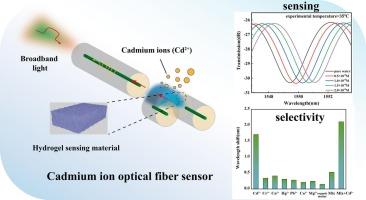Sensitive and selective Cd2+ sensing with a hydrogel-functionalized Fabry-Pérot fiber sensor
IF 4.6
2区 化学
Q1 SPECTROSCOPY
Spectrochimica Acta Part A: Molecular and Biomolecular Spectroscopy
Pub Date : 2025-09-25
DOI:10.1016/j.saa.2025.126988
引用次数: 0
Abstract
Achieving highly sensitive detection of ultra-low concentration cadmium ions (Cd2+) in water remains a critical challenge. This work proposes a novel fiber-optic Cd2+ sensor by integrating a Cd2+-responsive hydrogel with a refractive-index-sensitive Fabry-Pérot (F-P) interferometer fabricated via large-offset fusion splicing. The hydrogel, synthesized from allylthiourea/acrylic acid/acrylamide monomers, exhibits exceptional specificity and adsorption toward Cd2+ while forming a robust bond with the F-P fiber interferometer. The sensor demonstrates ultrahigh sensitivity of 8.58 × 107 nm/(mol/L) and a detection limit of 9.435 × 10−10 mol/L (0.1057 ppb)—two orders of magnitude below the World Health Organization (WHO) drinking water standard. The sensor also shows excellent selectivity (least 4.17 times higher response to Cd2+ than Cd2+, Cr3+, Cu2+, Hg2+, Pb2+, Ca2+, Mg2+ and soybean whey protein), stability (0.027 nm spectral drift deviation), and consistency (2.393 % sensitivity deviation across sensors). Thus, the proposed sensor provides a reliable solution for in situ monitoring of trace Cd2+ in environmental waters, showing significant potential for environmental monitoring applications.

敏感和选择性Cd2+传感与水凝胶功能化法布里- psamro纤维传感器。
实现水中超低浓度镉离子(Cd2+)的高灵敏度检测仍然是一个关键的挑战。本文提出了一种新型的光纤Cd2+传感器,该传感器将Cd2+响应水凝胶与折射率敏感的fabry - p干涉仪(F-P)集成在一起,该干涉仪是通过大偏移融合拼接制成的。由烯丙基硫脲/丙烯酸/丙烯酰胺单体合成的水凝胶对Cd2+具有特殊的特异性和吸附能力,同时与F-P光纤干涉仪形成牢固的键。该传感器具有8.58 × 107 nm/(mol/L)的超高灵敏度,检测限为9.435 × 10-10 mol/L (0.1057 ppb),比世界卫生组织(WHO)饮用水标准低两个数量级。该传感器对Cd2+的选择性(比Cd2+、Cr3+、Cu2+、Hg2+、Pb2+、Ca2+、Mg2+和大豆乳清蛋白的响应至少高4.17倍)、稳定性(0.027 nm光谱漂移偏差)和一致性(灵敏度偏差2.393%)。因此,所提出的传感器为环境水体中痕量Cd2+的原位监测提供了可靠的解决方案,显示出环境监测应用的巨大潜力。
本文章由计算机程序翻译,如有差异,请以英文原文为准。
求助全文
约1分钟内获得全文
求助全文
来源期刊
CiteScore
8.40
自引率
11.40%
发文量
1364
审稿时长
40 days
期刊介绍:
Spectrochimica Acta, Part A: Molecular and Biomolecular Spectroscopy (SAA) is an interdisciplinary journal which spans from basic to applied aspects of optical spectroscopy in chemistry, medicine, biology, and materials science.
The journal publishes original scientific papers that feature high-quality spectroscopic data and analysis. From the broad range of optical spectroscopies, the emphasis is on electronic, vibrational or rotational spectra of molecules, rather than on spectroscopy based on magnetic moments.
Criteria for publication in SAA are novelty, uniqueness, and outstanding quality. Routine applications of spectroscopic techniques and computational methods are not appropriate.
Topics of particular interest of Spectrochimica Acta Part A include, but are not limited to:
Spectroscopy and dynamics of bioanalytical, biomedical, environmental, and atmospheric sciences,
Novel experimental techniques or instrumentation for molecular spectroscopy,
Novel theoretical and computational methods,
Novel applications in photochemistry and photobiology,
Novel interpretational approaches as well as advances in data analysis based on electronic or vibrational spectroscopy.

 求助内容:
求助内容: 应助结果提醒方式:
应助结果提醒方式:


